Lumber and Lutheran Grit
Andy Sturdevant reflects on the peculiarly Minnesotan virtues of Chris Larson's work, marked both by "a plenitude of lumber" and old-fashioned Lutheran grit.
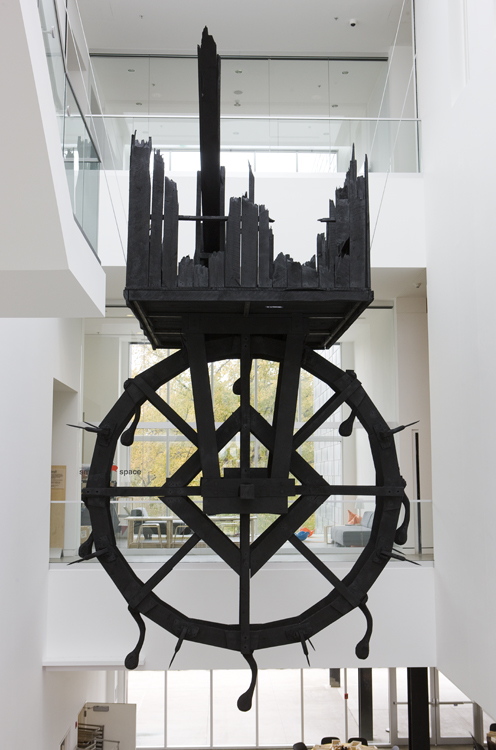
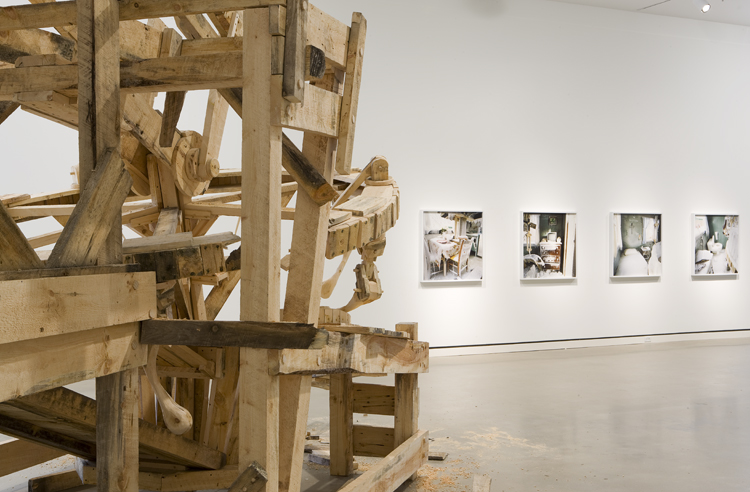
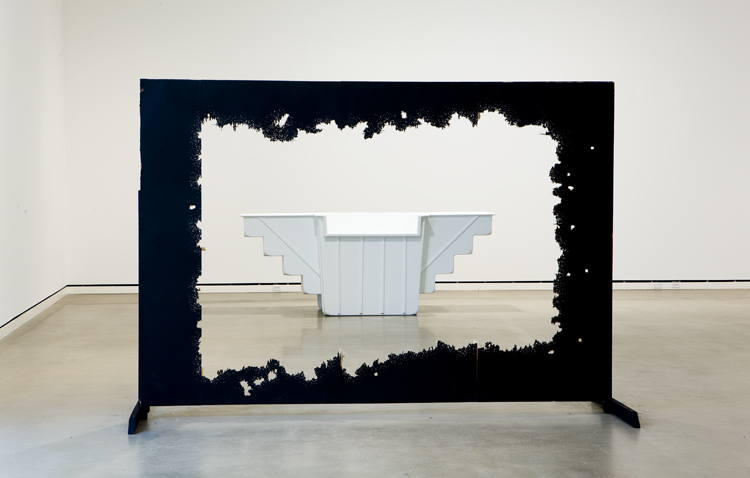
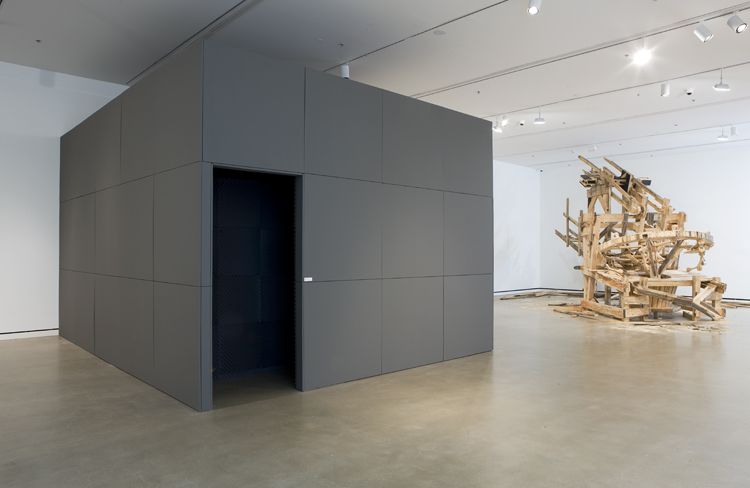

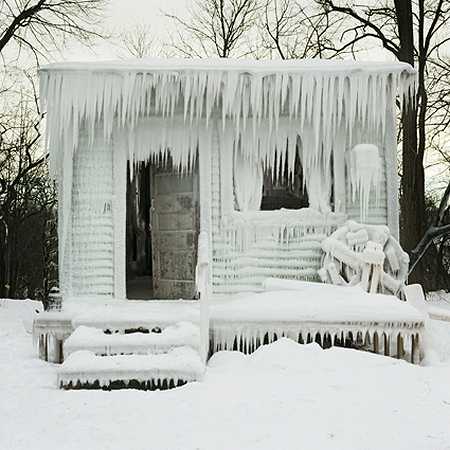
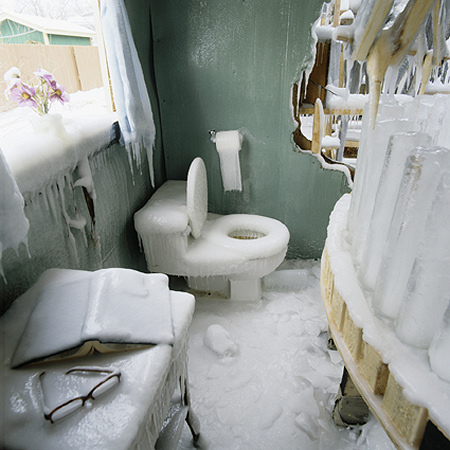
Ed. Note: It was recently announced that Chris Larson has been selected for inclusion in the 2014 Whitney Biennial. In honor of the news, we’re reprising Andy Sturdevant’s marvelous 2008 profile of the artist below.
One will not expect to find here the mellowness of cities, villages and countrysides in the older States. With the exception of a few villages, mostly in the southeastern section, the towns can claim little charm; the unbeautiful brick stores and banks of Main Street testify to grim physical work. Not many of the New England settlers had leisure to indulge their esthetic tastes, and the immigrants who poured into the State in the 1850’s were all too glad to exchange the picturesqueness and discomfort of their Old World stone cottages and thatched barns for a plentitude of lumber.
– “Minnesota Today,” The WPA Guide to Minnesota, 1938
ROCHESTER IS JUST SUCH A MINNESOTA TOWN, and one that can lay claim to very little charm, at least in its physical manifestation. It is through-and-through a company town – that company being the Mayo Clinic – and with the exception of a few picturesque old buildings like the Kahler Hotel, its downtown has little of the stereotypical romance of a small, Midwestern Main Street to recommend it. Unlike Red Wing or Stillwater or Winona, there’s almost no romance to Rochester, despite its being tucked away in some the most beautiful landscapes in the state. It’s a city-sized primer in contemporary institutional architecture; a series of sprawling, interconnected layers of frosted glass and steel and cement, plopped down overtop the framework of an old street grid, oblivious to its own charmlessness and content simply to hum along with the important business of healing the sick. A few blocks off of the downtown core at the head of one of the city’s main thoroughfares stands a statue of the two Mayo brothers, Charles and William, side-by-side in their surgical scrubs. The two doctors gaze upon downtown Rochester with a slightly bemused clinical detachment, as if to suggest “Yes, this is exactly what we had in mind. Now, we have a one o’clock surgery to get to.”
There’s a certain hard-bitten Protestant work ethic, a testimony to “grim physical work,” that runs as an undercurrent in the Minnesota psyche, transmitted from those New Englanders and Scandinavians who originally settled here. It’s an ethic that is expressed well in the roll-up-your sleeves, all-business feeling one gets from the Mayo Clinic and the town that surrounds it, the idea that it was all built by a plentitude of lumber and Lutheran grit. This is an ethic that artist Chris Larson understands – an ethic he embodies, actually – as one can see in the work in his new solo show at the Rochester Art Center.
In the promotional material for the exhibition on the center’s website, there is a quote cited from critic Mary Abbe, noting that there is a “hard-working carpenter quality” to Larson’s work “that does makes him seem very Minnesotan.” It’s perhaps no coincidence, then, that the centerpiece of the show, a video called Deep North and a series of photographs and sculptures derived from and referring to the video, reference Minnesota more explicitly than any of his work to date. Deep North and the work that surrounds it feels like, perhaps, one of the most profoundly Minnesotan pieces of art I have ever seen, up there with, say, Main Street and The Boat of Longing. Hell, Larson even manages to incorporate the state’s most widely-reproduced artwork, the 1918 photograph Grace by Eric Enstrom, into the piece. If referring to this show as “one of the most profoundly Minnesotan pieces of art I have ever seen” sounds like I’m damning it with faint praise, I am pointedly not. It’s an extremely difficult thing to invoke regionalism in art without seeming provincial or cornpone or boosterish about it, and Larson’s work is all the more remarkable for avoiding all three of those pitfalls, instead reaching for something deeper and more resonant.
So if that regionalism is going to be the fulcrum upon which this piece precariously rests, what does Abbe even mean, then, by “very Minnesotan”? I would refer back here to The WPA Guide to Minnesota, which seems like a very good place to begin.
I purchased a copy of the book the first year I lived here, because after a lifetime of being force-fed a certain radio personality’s monochromatic, yokel-centric vision of the state, I was interested in gathering some other perspectives. Assembled under the auspices of the Federal Writers’ Project in the depths of the Great Depression, the WPA Guide is one of my favorite nonfiction books on the subject of Minnesota. I admire it, not just because of the charmingly dated, Rooseveltian qualities of the prose, but because it’s so broad-minded and thorough in its assessment of the state and the people that built it. Though ostensibly a travel guide, the book’s emphasis, in true WPA fashion, is on the work, the process through which things are built and created – whether that’s the land, the traditions, the social fabric, or the great institutions. “Fame and success were to be the reward – if in less measure – for all who had talents for the arts or sciences,” notes one of the WPA writers, reflecting on the path through which Minnesota had traveled on its journey from frontier to commonwealth. “The only requisite,” the writer adds, “was that everyone should work.”
“There is something about who I am that is dictated by this place, the Midwest,” Larson himself says in an interview in the exhibition catalog. “There is something about the work ethic, about making things.”
____________________________________________________________________
Yet if he is to understand the Minnesota of today, he must keep in mind that within the span of a single lifetime 54 million acres of forests, lakes, rivers, and untouched prairies have been converted into an organized area of industrial cities and rich farms… The men and women who accomplished this were for the most part New Englanders, Germans and Scandinavians – probably as hardy as the world has produced – and it is their children and grandchildren who determine today the patterns of the contemporary scene.
– “Minnesota Today,” The WPA Guide to Minnesota, 1938
At the heart of Deep North’s video component is one of the enormous, hand-carved wooden machines that Larson has used in much of his work – almost too large and complex to believe it’s all fashioned from wood, but there it is. In fact, the RAC has suspended the machine from cables on the third story, out of its original context, and the whole contraption hovers just over a balcony in one of the negative spaces that gives the building its vertiginous sense of interior height.
In the video and the photographs, the machine is lodged inside a small, roofless house, the kind of modest one-story cottage you see in working-class neighborhoods like the East Side of St. Paul, which sit in rows on small plots of land. It is winter and snow is all around, and the roof has been sheared off, exposing the interior of the house to the elements. The machine looks as if it has been implanted in the center by some powerful force, clearing out any human inhabitants instantly. Indeed, the house is full of small, carefully-observed details of domestic life (the stove is half-open, eyeglasses and a Bible sit on the bed stand, Enstrom’s Grace hangs on a bedroom wall), but ice utterly encases everything, icicles hanging off of nearly any surface that will support them. The takeover is so complete as to suggest that ice itself is a sort of hostile, invasive species, and the effect is very unsettling. In the middle of this frozen tableau, the machine noisily cranks out chunks of ice, which slide down chutes and plop down on the floor, piling up around the edges of whoever’s abandoned home this is. (This is truly one of the most unsettling aspects of Deep North, that all the domestic details conclusively point to the fact that someone lived here, and that they are gone, probably for good.)
The ice, the forsaken house, the wooden behemoth at its center—it’s an utterly inhuman scene, and yet humanity is intimately involved. Three women impassively operate the enormous machine, turning the gears over, depressing levers, dressed for their labors in gray woolen jumpsuits and gloves, their breath visible as they work. Their work looks difficult and cold.
_________________________________________________
We are reminded every winter that our labor never ultimately triumphs over nature. We are reminded every time that arctic air blasts down across the prairie that we’re only one serious calamity away from living in a world like the icy, post-human interior of Larson’s cottage.
_________________________________________________
Larson has a knack for great casting in his videos, using former Husker Du drummer Grant Hart or the Minneapolis gospel group The Spiritual Knights, for example, as he did in 2006’s Crush Collision. The three women Larson casts in Deep North, including performance artist Brita Hallin, are similarly well-chosen for this project; they look, well, icy, as if they were carved from the frozen stuff themselves. I mean that in a positive way, too: their faces are wiped clean of any emotion and drained of expression, even in those close-up moments captured on video where you can clearly see them physically straining in their labor.
All this visible strain and chilly displacement, all of this labor, accomplishes… what exactly? Over the course of a single lifetime, we are told by the WPA Guide, Minnesota is transformed by incredible feats of labor into the place we know now, nature completely tamed, our tireless work ethic triumphant in the end. And yet we are reminded every winter that our labor never ultimately triumphs over nature; we are reminded every time that arctic air blasts down across the prairie that we’re only one serious calamity away from living in a world like the icy, post-human interior of Larson’s cottage. Our efforts merely hold nature’s extremes at bay and, even then, only temporarily. The world in winter is akin to one of Larson’s complex, perpetual motion machines, where humanity and nature are locked in an unending, cyclical struggle for dominance that is never resolved; the best one can hope for is a sort of grudging, mutual respect between the contending parties and sense of dignity imparted by the toil.
It’s no surprise that Larson’s work is suffused with Protestant imagery – the show also features a number of sculptures based on baptismal tanks, another type of inscrutable transformative machine. Experiencing Deep North, especially around this sort of imagery, it’s hard for me to not reach way, way back into the depths of my own Protestant upbringing (Southern Baptist, thank you). It calls to my mind a verse from the first book of Peter regarding the dignity of work: “But if, when ye do well, and suffer for it, yet take it patiently, this is acceptable with God.” That little Deep North house, split wide open and exposed and humming with activity, and its contents, the machine and the workers, the ice and the ephemeral objects it envelopes, the values and prejudices and beliefs all of those things represent —all these constituent pieces metaphorically comprise the entire psychic history of a way of life predicated on work, a way of life that seems, to me, particularly tied to Minnesota.
In an interview in the Rochester Art Center’s exhibition catalog, Larson refers to these pieces as “foundational stories,” these tenets and myths that he can’t seem to escape. “It is hard for me to think outside of them or around them,” he says, “especially if I am trying to talk about the beautiful mundanity of humanity.” Regarding these foundational stories, Chris Larson can be seen as the heir that the WPA Guide references above, the child and grandchild charged with determining the “patterns of the contemporary scene” (a fortuitous bit if intentional art world jargon there). So what patterns has Larson determined for our contemporary scene? The answer seems to be that the patterns don’t change much, really; we just keep on working and keep on working, exchanging “picturesequeness” for a plentitude of lumber.
About the author: Andy Sturdevant is a Minneapolis-based artist, curator, and writer who is a regular contributor to ARP! and Secrets of the City. He curated the History Room: 20 Years of No Name and the Soap Factory exhibition at The Soap Factory last season, and he is currently working on an accompanying book about the gallery’s history. Andy is also a contributor to the Electric Arc Radio Show music and performance series at the Ritz Theater in Minneapolis.